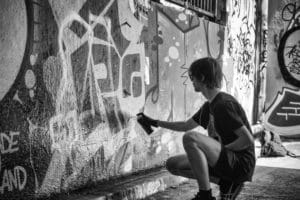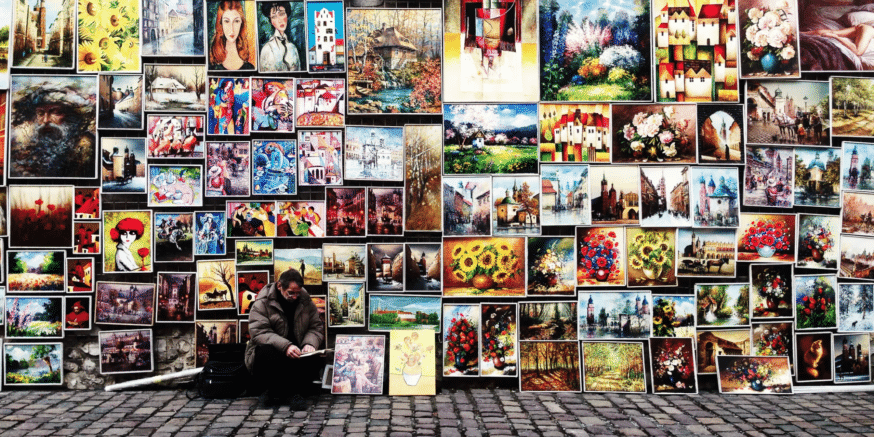Art is a notoriously hard place to make a living. For every artist who becomes famous, thousands of small artists exist in relative obscurity, working other jobs or barely eking out a living from their work. As a small artist, it can be difficult to book exhibitions, get your works hung in a gallery, or even sell artwork to the general public. Until you become known, you can’t charge higher prices, and getting well known is hard.
The blockchain art market could make it easier for small artists to get known and get paid. That’s because a decentralized marketplace can connect small artists directly to consumers without the gatekeepers and middlemen of galleries and auction houses. Additionally, blockchain art could open new funding streams for small artists and help them build their reputation over time. While the blockchain art revolution is only in its infancy and is by no means a sure thing, transitioning the art world to blockchain would be a boon for new creators.
More Connection

Moreover, if the industry moves toward blockchain art provenance and verification, much of the challenges of transacting and authenticating art could be handled online. In the future, buying and owning an expensive piece of art could be as simple as engaging a smart contract to purchase the artwork and the digital verification that comes along with it.
For small artists, this means the barriers to entry are now lower than ever. Creating a piece of art, verifying its authenticity, and listing it online can be simpler than ever. Smart contracts would allow artists to transact directly with customers and receive a larger portion of the profits.
There’s also increasing space for digital art that’s verified and sealed on the blockchain. Blockchain makes it so that digital art can’t be copied or pirated. A consumer can buy an original piece of art or a limited print of a piece directly on the blockchain without ever needing to leave their browser.
[thrive_leads id=’5219′]
New Funding Models
With blockchain, art can take on a life of its own as well. The traditional art model assumes that an artist will create a work of art and then a collector will purchase it. However, new projects like Plantoid and Harvest are challenging the traditional art funding model.
Plantoids are robotic works of art that live in public spaces. When someone admires the plantoid enough to come close, they’ll see a plaque indicating that they can donate to the project with Bitcoin. A donation makes the plantoid light up or respond in some other way. Once someone has donated, they earn a vote in the Plantoid project. The donations fund the creation of new plantoids, and donors can vote on how they should look and what artists they should hire to build the new plantoid.
In this way, plantoids are pioneering a realm of self-funding art that has a life of its own. It’s easy to imagine a painter doing something similar, where viewers who enjoy the art in a public space can donate to the project and vote on the artist’s future paintings.
Harvest is another art project that reimagines funding. However, Harvest doesn’t rely on donations. It’s a wind turbine that’s also an art installation. The turbine powers a Zcash mining rig, and the proceeds from the mining go to fund climate research.
This trend of art that pays for itself and pays for new art is growing. It’s an interesting idea with a lot of potential. Small artists could benefit from this trend because these new models provide ongoing cash flow, instead of one time payments.
Small Artists Reputation Building

Dynamic Pricing
A benefit and drawback of a blockchain art market is dynamic pricing. It could help artists if their works get more expensive as their popularity increases. However, many critics worry that an open marketplace for art could drive down prices. The result would be greater commoditization of creativity.
Lower prices for art could be great for introducing average consumers to the world of art collecting. Nevertheless, it would be detrimental to small artists who already don’t make a lot from their pursuits. Creating an open blockchain-based marketplace for art needs to have careful considerations that protect the artist and creativity, and avoid cheapening art.
Conclusion
The blockchain can be a benefit to small artists, but the emergence of a true blockchain art marketplace isn’t going to come any time soon. While small marketplaces like dada.nyc will continue to pop up, don’t expect galleries and other bastions of high-end art to go quietly. Ultimately, a hybrid system might be the best for protecting art from commoditization while still making art more accessible and opening new funding options for artistic endeavors.
Never Miss Another Opportunity! Get hand selected news & info from our Crypto Experts so you can make educated, informed decisions that directly affect your crypto profits. Subscribe to CoinCentral free newsletter now.










